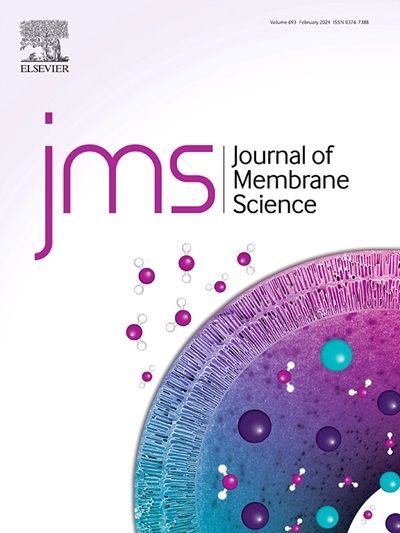New insights on the organic fouling mechanism of ultrafiltration membranes using hybrid QCM-D–LSPR
IF 8.4
1区 工程技术
Q1 ENGINEERING, CHEMICAL
引用次数: 0
Abstract
Organic fouling of ultrafiltration (UF) membranes is a major drawback and therefore, a rigorous analysis of the interactions of macromolecules with the outer membrane surface as well as with the confined porous membrane structure is required. This work provides new insights into the interplay between the interactions and conformation of alginate, a model organic foulant, as it penetrates the porous structure of an UF membrane. Alginate, like other organic foulants, can adopt conformations and orientations on the membrane surface that change in response to the aqueous conditions. In this work, adsorbed alginate layers were tested on a membrane-mimetic sensor surface using a hybrid system consisting of localized surface plasmon resonance (LSPR) sensing and quartz crystal microbalance with dissipation monitoring (QCM-D). The alginate conformation and adhesion on the sensor were consistent with the effects of alginate penetrating to the UF membrane pores affecting permeability at various ionic strengths. To study the interactions and conformational changes of alginate on the surface, the membrane surface and the hybrid sensor were given a positive charge by modifying them with species bearing primary amine groups, 2-aminoethyl methacrylate and 3-aminopropyl triethoxysilane, respectively. Intriguingly, on the pristine surfaces, increasing ionic strength induced a reversible increase in alginate areal density as measured by LSPR, indicating changes in alginate conformation, which increased the effective UF membrane pore diameter and increased membrane permeability. In contrast, the modified membranes with positive surfaces did not exhibit these changes in alginate conformation caused by ionic strength and membrane permeability showed no response to the aqueous ionic strength. This novel analysis of foulant conformation on a membrane-mimetic LSPR sensor, was further confirmed by the standard pore blocking model. QCM-D analysis revealed the expected responses to surface charge and ionic strength, i.e., the alginate layer's viscoelasticity increased on the positively charged surface and with increasing ionic strength. These analyses at the nanometer scale provide critical mechanistic insight into the way fouling reduces UF membrane performance.

求助全文
约1分钟内获得全文
求助全文
来源期刊

Journal of Membrane Science
工程技术-高分子科学
CiteScore
17.10
自引率
17.90%
发文量
1031
审稿时长
2.5 months
期刊介绍:
The Journal of Membrane Science is a publication that focuses on membrane systems and is aimed at academic and industrial chemists, chemical engineers, materials scientists, and membranologists. It publishes original research and reviews on various aspects of membrane transport, membrane formation/structure, fouling, module/process design, and processes/applications. The journal primarily focuses on the structure, function, and performance of non-biological membranes but also includes papers that relate to biological membranes. The Journal of Membrane Science publishes Full Text Papers, State-of-the-Art Reviews, Letters to the Editor, and Perspectives.
 求助内容:
求助内容: 应助结果提醒方式:
应助结果提醒方式:


